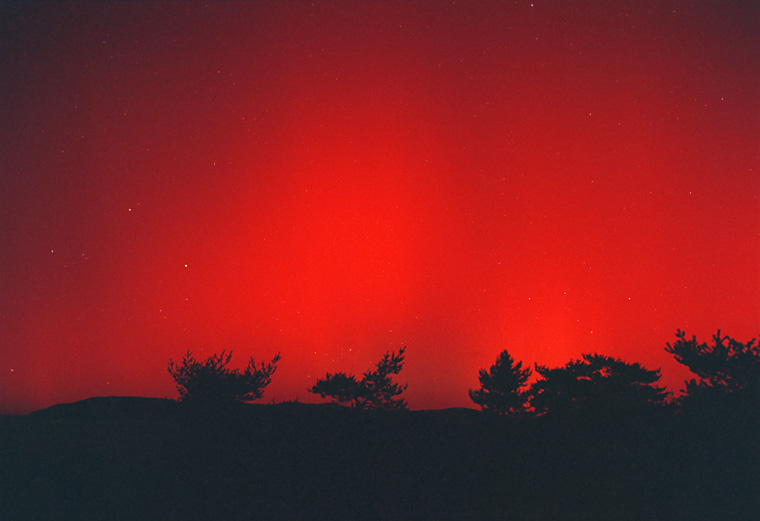
 |
This photograph shows a spectacular Aurora Borealis (Northern Lights) which was visible from southern France on the night of the 6/7th April 2000.
The peak activity occurred at around 1:30am local time on the 7th. During this time there were spectacular curtains and streamers in pinkish white colours, tinged with greenish hues. The predominant colour was a crimson red as shown in this photo which was taken at 1:50am, past the peak activity of the display.
I first became aware of something unusual at about 1:15am during an autoguided exposure in Leo. I noticed a reddish glow to the north and at first I thought it was a distant forest fire. As the minutes progressed I became aware that it was an Aurora, and by 1:30am it was quite spectacular. Only then did I appreciate that this was worthy of a photograph! (engage brain - I am supposed to be interested in astronomical photography!! :-) The display gradually subsided after 1:30am and disappeared altogether soon after 2:30am local time.
I rushed indoors and hurriedly assembled my Manfroto tripod (which was in pieces for transportation) and loaded my FM2 with film. Since all of my PJM-2 film was chilled I grabbed a roll of Kodak Royal Gold 400 ASA which I had bought for experimental purposes. I had never tried to photograph an Aurora before so I took various exposures between 5 seconds and 1 minute at f/4. Exposure times of around 10 seconds appeared to be best. Full details of the exposure are:
Date / Time / Location: 6 April 2000; 23:50 UT; Luberon - southern France
Camera / Lens: Nikon FM2 with Nikkor 24mm f/2.8 lens working at f/4
Film: Kodak Royal Gold 400 ASA
Exposure: 10 secondsNote: this shot may not have been critically focused - in my haste I merely set the focus to the infinity mark.
This photograph was taken looking NNW. To the left of the frame, just above the horizon, can be seen the stars of Auriga, with Capella clearly visible as the brightest star in this group. Towards the middle of the frame. a few of the stars of Perseus can be seen just above the second tree from the left. Towards the right of the frame, the stars of Cassiopeia can be seen above the fourth tree from the left.
Brief Explanation of the Northern Lights:
The Northen Lights are caused by the injection into the Earth's magnetic field of charged particles emitted by the sun, usually a few days after a storm has occurred on its surface. The interaction of this flow of particles with the planet's magnetic field produces a patterned electrical discharge which causes ionization of the rarified gases in the highest reaches of the atmosphere - normally between 100 and 300 miles above the Earth's surface.Because the Aurora normally follows a solar storm, it is clear that displays occur most frequently when the Sun's atmosphere is at its most active, and this activity follows a cycle of approximately 11 years - the "sunspot cycle" - so it is no surprise that this year's event came almost precisely 11 years after the last one.
We will remain near the peak of this cycle for another couple of years, so there is a reasonably good chance of further aurorae between now and 2002.
|
|
|
|